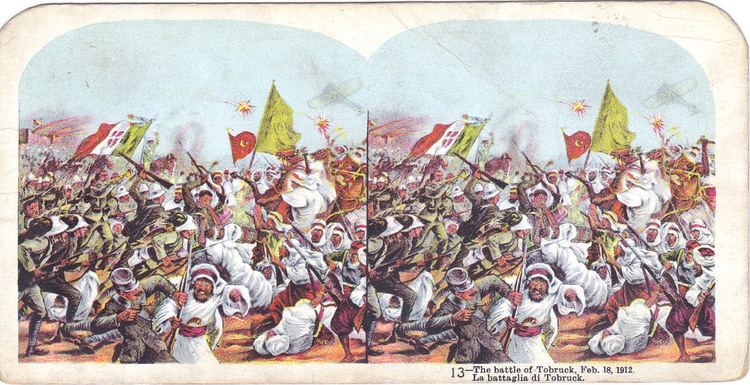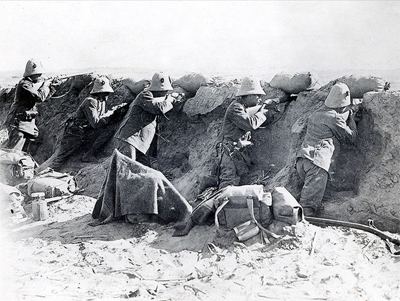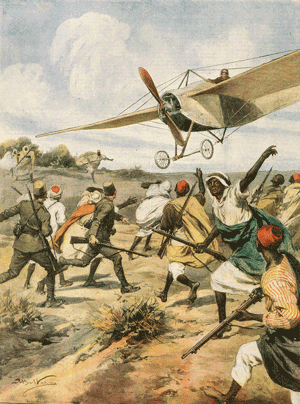Dates 29 Sep 1911 – 18 Oct 1912 | ||
 | ||
Expeditionary force 34,000 troops6,300 horses & mules1,050 waggons48 field guns24 mountain gunsReinforcements 85,000 troops 1,432 killed in combat 4,250 wounded 1,948 died of disease ~14,000 casualties 10,000 killed in reprisals & executions Similar Balkan Wars, Middle Eastern theatre of, Turkish War of Independence, Battle of Sakarya, First Balkan War | ||
Italo turkish war 3 minute history
The Italo-Turkish or Turco-Italian War (Turkish: Trablusgarp Savaşı, "Tripolitanian War"; also known in Italy as Guerra di Libia, "Libyan War") was fought between the Kingdom of Italy and the Ottoman Empire from September 29, 1911, to October 18, 1912. As a result of this conflict, Italy captured the Ottoman Tripolitania Vilayet (province), of which the main sub-provinces (sanjaks) were Fezzan, Cyrenaica, and Tripoli itself. These territories together formed what became known as Italian Libya.
Contents
- Italo turkish war 3 minute history
- The italo turkish war
- Background
- Opening maneuver
- Italian landing in Libya
- Trench phase
- Naval warfare
- Irregular war and atrocities
- Treaty of Lausanne
- Aftermath
- References

During the conflict, Italian forces also occupied the Dodecanese islands in the Aegean Sea. Italy had agreed to return the Dodecanese to the Ottoman Empire according to the Treaty of Ouchy in 1912 (also known as the First Treaty of Lausanne (1912), as it was signed at the Château d'Ouchy in Lausanne, Switzerland.) However, the vagueness of the text allowed a provisional Italian administration of the islands, and Turkey eventually renounced all claims on these islands in Article 15 of the Treaty of Lausanne in 1923.

Although minor, the war was a significant precursor of the First World War as it sparked nationalism in the Balkan states. Seeing how easily the Italians had defeated the weakened Ottomans, the members of the Balkan League attacked the Ottoman Empire before the war with Italy had ended.

The Italo-Turkish War saw numerous technological changes, notably the airplane. On October 23, 1911, an Italian pilot, Captain Carlo Piazza, flew over Turkish lines on the world's first aerial reconnaissance mission, and on November 1, the first ever aerial bomb was dropped by Sottotenente Giulio Gavotti, on Turkish troops in Libya, from an early model of Etrich Taube aircraft. The Turks, lacking anti-aircraft weapons, were the first to shoot down an aeroplane by rifle fire.

The italo turkish war
Background

The claims of Italy over Libya dated back to Turkey's defeat by Russia in the war of 1877–1878 and subsequent discussions after the Congress of Berlin in 1878, in which France and Great Britain had agreed to the occupation of Tunisia and Cyprus respectively, both parts of the then declining Ottoman Empire. When Italian diplomats hinted about possible opposition by their government, the French replied that Tripoli would have been a counterpart for Italy. In 1902, Italy and France had signed a secret treaty which accorded freedom of intervention in Tripolitania and Morocco. However, the Italian government did little to realize the opportunity and knowledge of Libyan territory and resources remained scarce in the following years.
The Italian press began a large-scale lobbying campaign in favour of an invasion of Libya at the end of March 1911. It was fancifully depicted as rich in minerals, well-watered, and defended by only 4,000 Ottoman troops. Also, the population was described as hostile to the Ottoman Empire and friendly to the Italians: the future invasion was going to be little more than a "military walk", according to them.
The Italian government was hesitant initially, but in the summer the preparations for the invasion were carried out and Prime Minister Giovanni Giolitti began to probe the other European major powers about their reactions to a possible invasion of Libya. The Socialist Party had strong influence over public opinion. However, it was in opposition and also divided on the issue. It acted ineffectively against a military intervention. The future fascist leader Benito Mussolini – at this time still a left-wing Socialist – took a prominent anti-war position. A similar opposition was expressed in Parliament by Gaetano Salvemini and Leone Caetani.
An ultimatum was presented to the Ottoman government led by the Committee of Union and Progress (CUP) party on the night of 26–27 September. Through Austrian intermediation, the Ottomans replied with the proposal of transferring control of Libya without war, maintaining a formal Ottoman suzerainty. This suggestion was comparable to the situation in Egypt, which was under formal Ottoman suzerainty, but was actually controlled by the United Kingdom. Giolitti refused, and war was declared on September 29, 1911.
Opening maneuver
Despite the time it had had to prepare the invasion, the Italian Royal Army (Regio Esercito) was largely unprepared when the war broke out. The Italian fleet appeared off Tripoli in the evening of September 28, but only began bombarding the port on October 3. The city was conquered by 1,500 sailors, much to the enthusiasm of the interventionist minority in Italy. Another proposal for a diplomatic settlement was rejected by the Italians, and the Turks determined therefore to defend the province.
The Turks did not have a full army in Trablusgarp (Libya). Many of the Ottoman officers had to travel there by their own means, often secretly, through Egypt, since the British would not allow Turkish troops to be transported en masse through Egypt. The Ottoman Navy was too weak to transport troops by sea. The Turks organized local Arabs and Bedouins for the defence against the Italian invasion.
Italian landing in Libya
Between 1911 and 1912, over 1,000 Somalis from Mogadishu, the then capital of Italian Somaliland, served as combat units along with Eritrean and Italian soldiers in the Italo-Turkish War. Most of the troops stationed never returned home until they were transferred back to Italian Somaliland in preparation for the invasion of Ethiopia in 1935. The first disembarkation of Italian troops occurred on October 10. The Italian contingent of 20,000 troops was deemed sufficient to accomplish the conquest at the time. Tobruk, Derna and Khoms were easily conquered, but the same was not true for Benghazi. The first true setback for the Italian troops happened on October 23, when poor placement of the troops near Tripoli led them to be almost completely encircled by more mobile Arab cavalry, backed by some Turkish regular units. The attack was portrayed as a simple revolt by the Italian press, but it nearly annihilated much of the small Italian expeditionary corps.
The corps was consequently enlarged to 100,000 men who had to face 20,000 Arabs and 8,000 Turks. The war turned into one of position. Even some of the earliest examples of utilisation in modern warfare of armoured cars and air power by the Italian forces had little effect on the initial outcome. However, the war was notable for the first military use of heavier than air craft. Capitano Carlo Piazza flew the first military reconnaissance flight on 23 October 1911. A week later, Sottotenente Giulio Gavotti dropped four grenades on Taguira and Ain Zara in history's first aerial bombing.
Trench phase
The Arabs and Turks, estimated at 15,000, made frequent attacks by day and night on the strongly entrenched Italian garrison in the southern suburbs of Benghazi. The four Italian regiments of infantry acted on the defensive and were supported by the San Marco and Agordat. The Italians rarely attempted a sortie.
An attack of 20,000 Turkish and local troops was repulsed on November 30 with considerable losses. Shortly after this the garrison was reinforced by the 57th infantry regiment from Italy. The battleship Regina Elena also arrived from Tobruk. During the night of December 14 and 15 the Turks attacked in great force, but were repulsed by aid of the fire from the ships. The Italians lost several field guns.
At Derna the Turks and Arabs were estimated at 3,500, but they were being constantly reinforced and a general assault on the Italian position was expected. The Italian and Turkish forces in Tripoli and Cyrenaica were constantly reinforced. The withdrawal of the Turks into the interior enabled them to reinforce their troops considerably.
The cost of the war was defrayed chiefly by voluntary offerings from Muslims. Turkish officers and men, weapons, ammunition, and all kinds of supplies were constantly sent across the Egyptian and Tunisian frontiers, notwithstanding their neutrality. The Italians occupied Sidi Barrani on the coast between Tobruk and Solum to prevent contraband and troops from entering across the Egyptian frontier, while the naval blockaders guarded the coast and captured several sailing ships with contraband.
Successively Italian troops landed at Tobruk after a brief bombardment on December 4, 1911, occupied the seashore and marched towards the hinterlands facing weak resistance. Small numbers of Turkish soldiers and Libyan volunteers were later organized by Captain Mustafa Kemal Atatürk. The small December 22 Battle of Tobruk resulted in Mustafa Kemal's victory. With this achievement, he was assigned to Derna War quarters to coordinate the field on March 6, 1912. The Libyan campaign ground to a stalemate by December 1911.
On 3 March 1912, 1,500 Libyan volunteers attacked Italian troops who were building trenches near Derna. The Italians, who were outnumbered but had superior weaponry, held the line. A lack of coordination between the Italian units sent from Derna as reinforcements and the intervention of Turkish artillery threatened the Italian line, and the Arabs attempted to surround the Italian troops. Further Italian reinforcements, however, were able to stabilise the situation, and the battle ended in the afternoon with an Italian victory.
On September 14, the Italian command sent three columns of infantry to disband the Arab Turkish camp near Derna. The Italian troops occupied a plateau, interrupting Turkish supply lines. Three days later, the Turkish commander, Enver Bey, attacked the Italian positions on the plateau. The larger Italian fire drove back the Turkish soldiers, who were surrounded by a battalion of Alpini and suffered heavy losses. A later Turkish attack had the same outcome. After that, operations in Cyrenaica ceased until the end of the war. Although some elements of the local population collaborated with the Italians, counterattacks by Turkish soldiers with the help of local troops confined the Italian army to the coastal region. In fact, by the end of 1912 the Italians had made little progress in conquering Libya. The Italian soldiers were, in effect, besieged in seven enclaves on the coasts of Tripolitania and Cyrenaica. The largest of these, at Tripoli, extended barely 15 kilometers (9.3 miles) from the town.
Naval warfare
At sea, the Italians enjoyed a clear advantage. The Italian navy had seven times the tonnage of the Ottoman navy and was better trained.
In January 1912, the Italian cruiser Piemonte, with the Soldato class destroyers Artigliere and Garibaldino, sank seven Turkish gunboats (Ayintab, Bafra, Gökcedag, Kastamonu, Muha, Ordu and Refahiye) and a yacht (Sipka) in the Battle of Kunfuda Bay. Successively the Italians blockaded the Red Sea ports of the Ottomans, while actively supplying and supporting the Emirate of Asir which was also concurrantly at war with the Ottoman Empire.
Then, on 24 February, in the Battle of Beirut, two Italian armoured cruisers attacked and sank an Ottoman casemate corvette and six lighters, retreated, then returned and sank an Ottoman torpedo boat. Avnillah alone suffered 58 killed and 108 wounded. By contrast the Italian ships not only took no casualties, but no direct hits from the Ottoman warships at all. Italy had feared that the Ottoman naval forces at Beirut could be used to threaten the approach to the Suez Canal. The Ottoman naval presence at Beirut was completely annihilated and casualties on the Ottoman side were heavy. The Italian navy gained complete naval dominance of the southern Mediterranean for the rest of the war.
Although Italy could extend its control to almost all of the 2,000 km of the Libyan coast between April and early August 1912, its ground forces could not venture beyond the protection of the navy's guns and were thus limited to a thin coastal strip. In the summer of 1912, Italy began operations against the Turkish possessions in the Aegean Sea with the approval of the other powers that were eager to end a war that was lasting much longer than expected. Italy occupied twelve islands in the sea, comprising the Ottoman province of Rhodes, which henceforth became known as the Dodecanese, but this raised the discontent of Austria-Hungary, which feared that this could fuel the irredentism of nations such as Serbia and Greece, causing imbalance in the already fragile situation in the Balkan area. The only other relevant military operation of the summer was an attack of five Italian torpedo boats in the Dardanelles on 18 July.
Irregular war and atrocities
With a decree of November 5, 1911, Italy declared its suzerainty over Libya. Although it controlled the coast, many of the Ottoman troops were not killed in battle and nearly 6,000 remained to face an army of nearly 140,000 Italians. As a result, the Ottomans began using guerrilla tactics. Indeed, some "Young Turk" officers reached Libya and helped organize a guerrilla war with local mujahideens. Many local Arabs joined forces with the Turks because of their common faith against the "Christian invaders" and started a bloody guerrilla warfare: Italian authorities adopted many repressive measures against the rebels, such as public hanging as a retaliation for ambushes.
On October 23, 1911 nearly 500 Italian soldiers were slaughtered at Sciara Sciatt in the outskirt of Tripoli by Turkish troops. As a consequence in the next day—during the 1911 Tripoli massacre—Italian troops systematically murdered hundreds of civilians by moving through the local homes and gardens one by one, including setting fire in the fighting to a mosque with one hundred refugees inside. Although Italian authorities attempted to keep the news of the massacre from getting out, the incident soon became internationally known. The Italians started to show photos of the massacred Italian soldiers at Sciara Sciat in order to justify their revenge.
Treaty of Lausanne
Italian diplomats decided to take advantage of the situation to obtain a favourable peace deal. On October 18, 1912, Italy and the Ottoman Empire signed a treaty in Ouchy near Lausanne (the First Treaty of Lausanne).
The main provisions of the treaty, often also called Treaty of Ouchy to distinguish it from the 1923 Treaty of Lausanne, were as follows:
Aftermath
The invasion of Libya was a costly enterprise for Italy. Instead of the 30 million lire a month judged sufficient at its beginning, it reached a cost of 80 million a month for a much longer period than was originally estimated. The war cost Italy 1.3 billion lire, nearly a billion more than Giovanni Giolitti estimated before the war. This ruined ten years of fiscal prudence.
After the withdrawal of the Ottoman army the Italians could easily extend their occupation of the country, seizing East Tripolitania, Ghadames, the Djebel and Fezzan with Murzuk during 1913. The outbreak of the First World War with the necessity to bring back the troops to Italy, the proclamation of the Jihad by the Ottomans and the uprising of the Libyans in Tripolitania forced the Italians to abandon all occupied territory and to entrench themselves in Tripoli, Derna, and on the coast of Cyrenaica. The Italian control over much of the interior of Libya remained ineffective until the late 1920s, when forces under the Generals Pietro Badoglio and Rodolfo Graziani waged bloody pacification campaigns. Resistance petered out only after the execution of the rebel leader Omar Mukhtar on September 15, 1931. The result of the Italian colonisation for the Libyan population was that by the mid-1930s it had been cut in half due to emigration, famine, and war casualties. The Libyan population in 1950 was at the same level as in 1911, approximately 1.5 million.
Because of World War I, the Dodecanese remained under Italian military occupation. According to the 1920 Treaty of Sèvres, which was never ratified, Italy was supposed to cede all of the islands except Rhodes to Greece, in exchange for a vast Italian zone of influence in southwest Anatolia.
However, the Greek defeat in the Greco–Turkish War and the foundation of modern Turkey created a new situation that made the enforcement of the terms of this treaty impossible. In article 15 of the 1923 Treaty of Lausanne, which superseded the 1920 Treaty of Sèvres, Turkey formally recognized the Italian annexation of the Dodecanese. The population was largely Greek, and by treaty in 1947 they became part of Greece.
